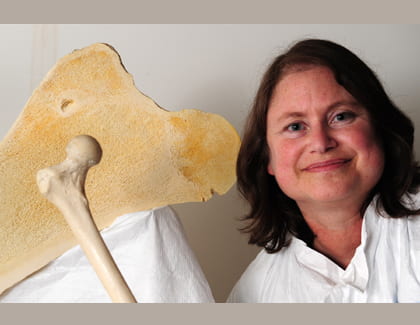A bone to pick
Joyce Keyak takes her expertise in engineering and orthopedics to help treat cancer

Bones are strong, but Joyce Keyak knows they’re not always strong enough.
Osteoporosis can weaken them and cancer can cause damage, so she has spent her career as an engineer and orthopedic researcher finding ways to rectify this.
Keyak created a technique to evaluate the strength of the hip bone, which has proven invaluable for improving care of people with osteoporosis and weakened bones susceptible to breaks. In the elderly, a broken hip can have traumatic repercussions.
“If you have osteoporosis and break your hip, you face major problems,” Keyak says. “Half the people who break their hips never walk again, and up to 20 percent die within a year. Being able to gauge bone strength can help doctors work with their patients to prevent hip fractures.”
Keyak has since focused her expertise on another illness that can weaken and destroy bones – cancer.
Cancers that begin in the breast, prostate, lung, thyroid and kidney can spread to and disintegrate bones, most commonly the bones in the back. Complicating the condition further, normal radiation treatments for this problem can threaten the spinal cord and cause paralysis.
Keyak worked with colleagues in orthopedic surgery to take a common product of their trade, bone cement, and infuse it with radioactive material that is already used for other treatment.
They have started a company, Bone-Rad Therapeutics, to create the first radioactive bone cement to fight tumors while strengthening the bone.
Normally, a bone cancer patient needs 10 sessions of radiation therapy. But with the Bone-Rad product, according to Keyak, a single injection of the radioactive bone cement can provide an equivalent, targeted tumor treatment with significantly less threat to the spinal cord and nerves. She hopes their product will hit the market within two years.
“What excites me about this project is that it can help hundreds of thousands of cancer patients,” Keyak says. “Not many people have the opportunity to make such a difference. It’s thrilling.”